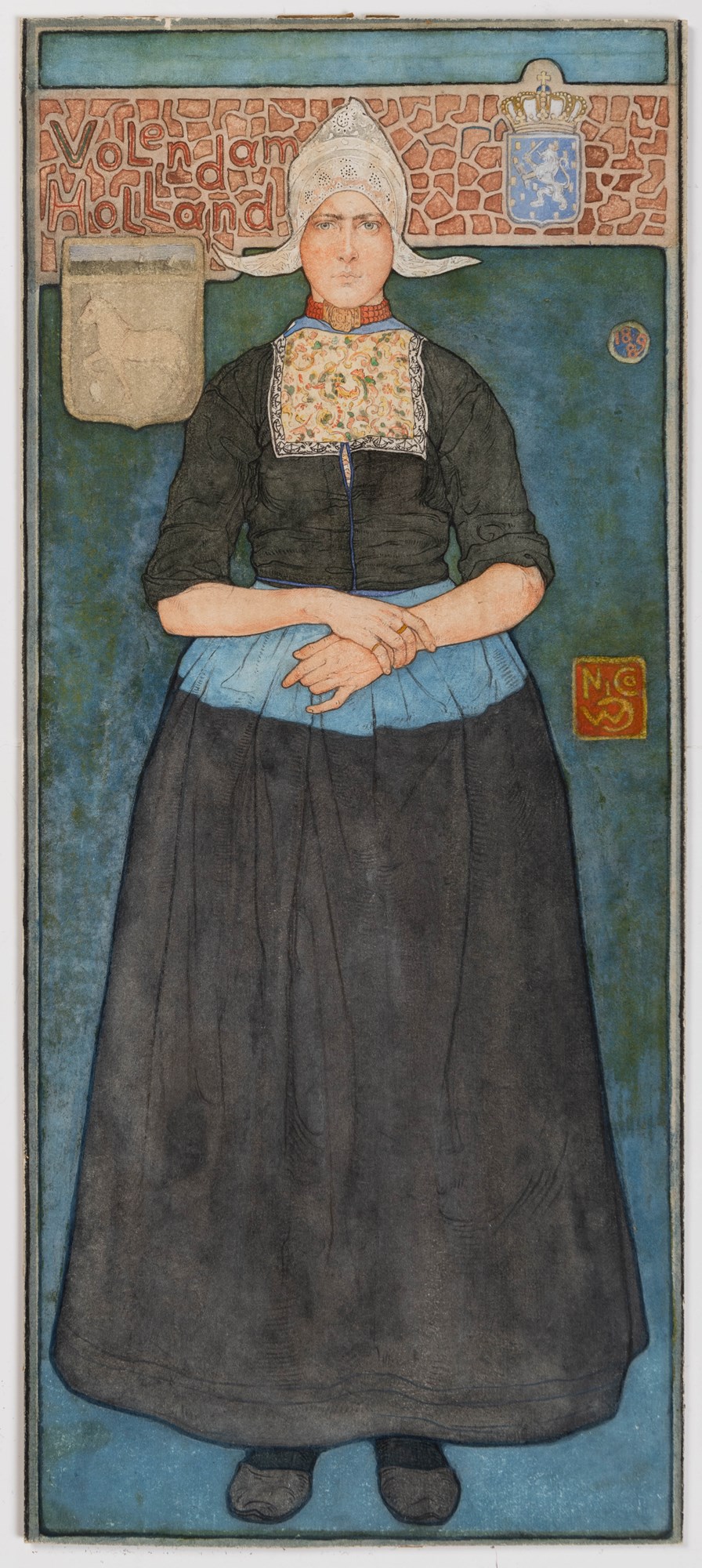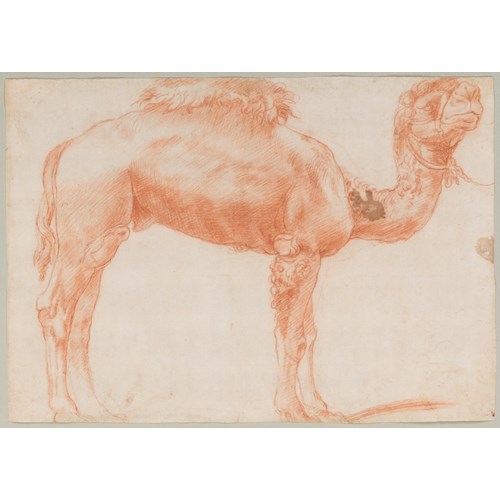Marketplace
A Woman from Volendam
Nico Jungmann often worked in the Dutch town of Volendam, about twenty kilometres northeast of Amsterdam, and became particularly associated with paintings and drawings of Volendam and its inhabitants in their traditional costumes. Volendam was originally the harbour of the nearby town of Edam, at the mouth of the Ij bay. However, in the 14th century a shorter route from Edam to the Zuiderzee was dug as a canal, and the village was no longer used as a port. The harbour was filled with earth (the name Volendam translates as something akin to ‘filled dam’) and the village was settled by fishermen and farmers, but for the most part remained resolutely untouched by modern life. Volendam attracted numerous artists, and such foreign painters as George Clausen, Walter Langley, Pablo Picasso, Auguste Renoir, Frits Thaulow and Théo van Rysselberghe are known to have spent time there, usually staying at the Hotel Spaander, which was the centre of artistic life in the town. Volendam remains a popular tourist destination today, known for its old houses, quaint fishing boats, and the distinctive costumes still worn by many of the Volendammers.
In one of the earliest accounts of the artist’s work in English, published in The Studio in 1898, it was stated that ‘Mr. Jungmann is an artist with a strong individuality that has so far found its fullest expression in studies of figures rather than in pictures, or even in designs, as the terms are conventionally understood. In 1896 he returned to Holland, and did much work at Vollendam, one of its most picturesque sketching-grounds. In the water-colours and pencil drawings he made there his aim has been (to quote his own words) “to make studies per se, and make them express their own character.” Later on he hopes to proceed to finished paintings; but for a while he is satisfied to complete isolated decorative drawings…The actual drawings are made with a sort of crayon of his own preparation, and to an outsider the results appear to be just elaborate pencil studies. But the curious power and realism of his completed sketches are accompanied by so much remarkable subtlety in the use of line, that face to face with the actual work one cannot help feeling inclined, under the influence of a first impression, to forbear from any further and lengthier analysis, and to rest content with the ensemble. After the drawing has been advanced to this stage, Mr. Jungmann adds the necessary colour, and the work is complete…Mr. Jungmann has developed a highly personal manner of expression. Selecting subjects from his native country, he has recorded them in a way that is at once singularly like the effect of a good Japanese colour-print…Mr. Jungmann, whether consciously or the reverse, has in these studies of Dutch peasants approached the effect of a first-rate Japanese colour-print…They are not pictures in the popular sense, for their incident is simple, they owe nothing to anecdote and little to sentiment; but as decoration of the best sort a single one would add distinction to any room. Like the matchless drawings by Holbein now at Windsor Castle, and the masterpieces of Japan, they are self-contained works of art…The frank delight they arouse is not of a sort that might attract the average picture lover, but to those who can appreciate virtuosity without affectation – a transcript of life, idealised by its maker to be a work of art, and in no way “prettified” in the process – they are memorable…Mr. Jungmann has found a field of his own, and the soil under his cultivation has already yielded a promising crop. He dreams of greater things, and will do them.’
Writing the following year, the art critic P. G. Konody similarly found praise for ‘Nico Jungman, whose delightful Volendam genre-pictures have just recently scored an enormous and well-deserved success at a Bond Street exhibition; in his work the quaint costume appears to be the main purpose of the picture; everything else is mere after-thought. His technique is exquisite, his drawing admirable, his colour very decorative; his pictures will always please and even delight…’
The present sheet is a relatively early work by Jungmann, executed in 1889, a few years before he settled in London. The dress of the women of Volendam, characterized by a high, pointed bonnet, is among the most distinctive and recognizable of traditional Dutch costumes. Prominent in this work, beneath the name of the town, are the coat of arms of Volendam, depicting a horse stepping on a flounder, while at the upper right are the arms of the Kingdom of the Netherlands.
In one of the earliest accounts of the artist’s work in English, published in The Studio in 1898, it was stated that ‘Mr. Jungmann is an artist with a strong individuality that has so far found its fullest expression in studies of figures rather than in pictures, or even in designs, as the terms are conventionally understood. In 1896 he returned to Holland, and did much work at Vollendam, one of its most picturesque sketching-grounds. In the water-colours and pencil drawings he made there his aim has been (to quote his own words) “to make studies per se, and make them express their own character.” Later on he hopes to proceed to finished paintings; but for a while he is satisfied to complete isolated decorative drawings…The actual drawings are made with a sort of crayon of his own preparation, and to an outsider the results appear to be just elaborate pencil studies. But the curious power and realism of his completed sketches are accompanied by so much remarkable subtlety in the use of line, that face to face with the actual work one cannot help feeling inclined, under the influence of a first impression, to forbear from any further and lengthier analysis, and to rest content with the ensemble. After the drawing has been advanced to this stage, Mr. Jungmann adds the necessary colour, and the work is complete…Mr. Jungmann has developed a highly personal manner of expression. Selecting subjects from his native country, he has recorded them in a way that is at once singularly like the effect of a good Japanese colour-print…Mr. Jungmann, whether consciously or the reverse, has in these studies of Dutch peasants approached the effect of a first-rate Japanese colour-print…They are not pictures in the popular sense, for their incident is simple, they owe nothing to anecdote and little to sentiment; but as decoration of the best sort a single one would add distinction to any room. Like the matchless drawings by Holbein now at Windsor Castle, and the masterpieces of Japan, they are self-contained works of art…The frank delight they arouse is not of a sort that might attract the average picture lover, but to those who can appreciate virtuosity without affectation – a transcript of life, idealised by its maker to be a work of art, and in no way “prettified” in the process – they are memorable…Mr. Jungmann has found a field of his own, and the soil under his cultivation has already yielded a promising crop. He dreams of greater things, and will do them.’
Writing the following year, the art critic P. G. Konody similarly found praise for ‘Nico Jungman, whose delightful Volendam genre-pictures have just recently scored an enormous and well-deserved success at a Bond Street exhibition; in his work the quaint costume appears to be the main purpose of the picture; everything else is mere after-thought. His technique is exquisite, his drawing admirable, his colour very decorative; his pictures will always please and even delight…’
The present sheet is a relatively early work by Jungmann, executed in 1889, a few years before he settled in London. The dress of the women of Volendam, characterized by a high, pointed bonnet, is among the most distinctive and recognizable of traditional Dutch costumes. Prominent in this work, beneath the name of the town, are the coat of arms of Volendam, depicting a horse stepping on a flounder, while at the upper right are the arms of the Kingdom of the Netherlands.
Provenance: Anonymous sale, Middelburg, Veilinghuis Korendijk, 2 September 2024, lot 1282.
Plus d'œuvres d'art de la Galerie









